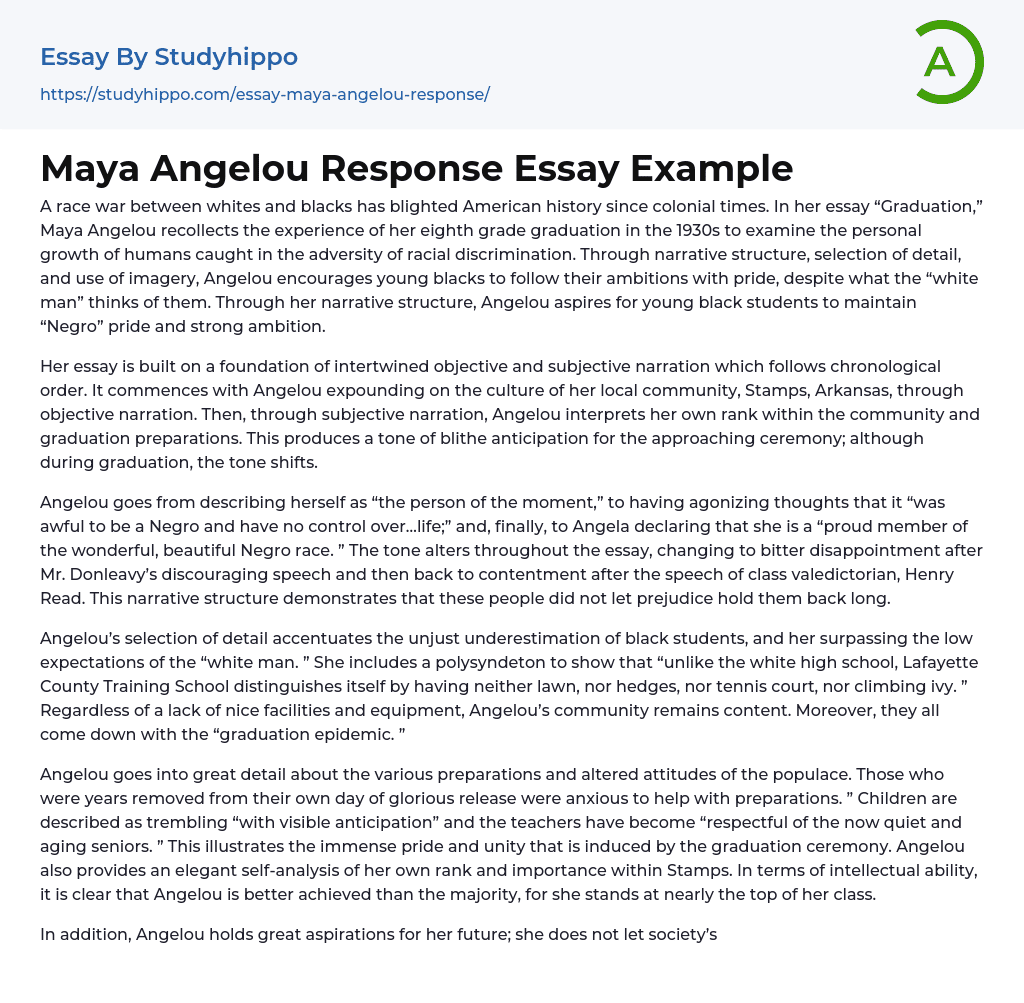A race war between whites and blacks has blighted American history since colonial times. In her essay “Graduation,” Maya Angelou recollects the experience of her eighth grade graduation in the 1930s to examine the personal growth of humans caught in the adversity of racial discrimination. Through narrative structure, selection of detail, and use of imagery, Angelou encourages young blacks to follow their ambitions with pride, despite what the “white man” thinks of them. Through her narrative structure, Angelou aspires for young black students to maintain “Negro” pride and strong ambition.
Her essay is built on a foundation of intertwined objective and subjective narration which follows chronological order. It commences with Angelou expounding on the culture of her local community, Stamps, Arkansas, through objective narration. Then, through subjective narration, Angelou interprets her own rank within the community and
...graduation preparations. This produces a tone of blithe anticipation for the approaching ceremony; although during graduation, the tone shifts.
Angelou goes from describing herself as “the person of the moment,” to having agonizing thoughts that it “was awful to be a Negro and have no control over…life;” and, finally, to Angela declaring that she is a “proud member of the wonderful, beautiful Negro race. ” The tone alters throughout the essay, changing to bitter disappointment after Mr. Donleavy’s discouraging speech and then back to contentment after the speech of class valedictorian, Henry Read. This narrative structure demonstrates that these people did not let prejudice hold them back long.
Angelou’s selection of detail accentuates the unjust underestimation of black students, and her surpassing the low expectations of the “white man. ” She includes a polysyndeton to show that “unlike the white hig
school, Lafayette County Training School distinguishes itself by having neither lawn, nor hedges, nor tennis court, nor climbing ivy. ” Regardless of a lack of nice facilities and equipment, Angelou’s community remains content. Moreover, they all come down with the “graduation epidemic. ”
Angelou goes into great detail about the various preparations and altered attitudes of the populace. Those who were years removed from their own day of glorious release were anxious to help with preparations. ” Children are described as trembling “with visible anticipation” and the teachers have become “respectful of the now quiet and aging seniors. ” This illustrates the immense pride and unity that is induced by the graduation ceremony. Angelou also provides an elegant self-analysis of her own rank and importance within Stamps. In terms of intellectual ability, it is clear that Angelou is better achieved than the majority, for she stands at nearly the top of her class.
In addition, Angelou holds great aspirations for her future; she does not let society’s low expectations keep her from excelling. With imagery, Angelou emphasizes the appearance of the graduates and their reaction to Donleavy’s racism. She transmits this using a variety of techniques; the most common trope being similes. However, Angelou also utilizes other devices such as metaphors and personification. Before the graduation ceremony, Angelou uses visual imagery to vividly accentuate the appearance of her and the other graduates.
They are “the real nobility;” Angelou is “a walking model of all the various styles of fine hand sewing” and “looks like a sunbeam. ” They are all dignifiedly dressed. During the ceremony, Angelou uses imagery to intensify the reaction to Donleavy’s speech via personifying the
resulting ugliness as “an uninvited guest who wouldn’t leave. ” “The man’s words fell like bricks around the auditorium. ” At first, the blacks are dicouraged by Donleavy humiliating them; but after Read’s speech, the blissful atmosphere returns.
“The depths had been icy and dark, but now a bright sun spoke to our souls. The “white man” could not dishearten this strong, ambitious group. Despite the perspective of cynical, white higher-ups, Angelou conveys her aspiration for young blacks to uphold their pride and ambition through her narrative structure, selection of detail, and use of imagery. Angelou’s experience with racism is only one among a plethora of others; however as Angelou has revealed, the “Negro” race can be a strong, unshakable unit. Ultimately, discrimination will never be completely destroyed; though like in America, it can be fought and suppressed with effort. As Patrick Henry said, “Give me liberty of give me death. ”
- Malcolm X essays
- Black Lives Matter essays
- Antisemitism essays
- Ku Klux Klan essays
- Miscegenation essays
- Racial Segregation essays
- I Have a Dream essays
- Martin Luther King essays
- Racial Inequality essays
- Black History Month essays
- Black People essays
- Aldous Huxley essays
- Alice Walker essays
- Amy tan essays
- Anne Bradstreet essays
- Anton Chekhov essays
- Arthur Miller essays
- Augustine essays
- Bertolt Brecht essays
- Booker T Washington essays
- Carol ann duffy essays
- Charles Dickens essays
- Charlotte Perkins Gilman essays
- Chinua Achebe essays
- Christina Rossetti essays
- Consider The Lobster essays
- Edgar Allan Poe essays
- Elizabeth Bishop essays
- Emily Dickinson essays
- Ernest Hemingway essays
- F. Scott Fitzgerald essays
- George Orwell essays
- Harper Lee essays
- Homer essays
- James Baldwin essays
- Jane Austen essays
- John Donne essays
- John Steinbeck essays
- Kate Chopin essays
- Kurt Vonnegut essays
- Langston Hughes essays
- Leonardo Da Vinci essays
- Mark Twain essays
- Mary Shelley essays
- Maya Angelou essays
- Nathaniel Hawthorne essays
- Oscar Wilde essays
- Percy Bysshe Shelley essays
- Peter Skrzynecki essays
- Phillis Wheatley essays




